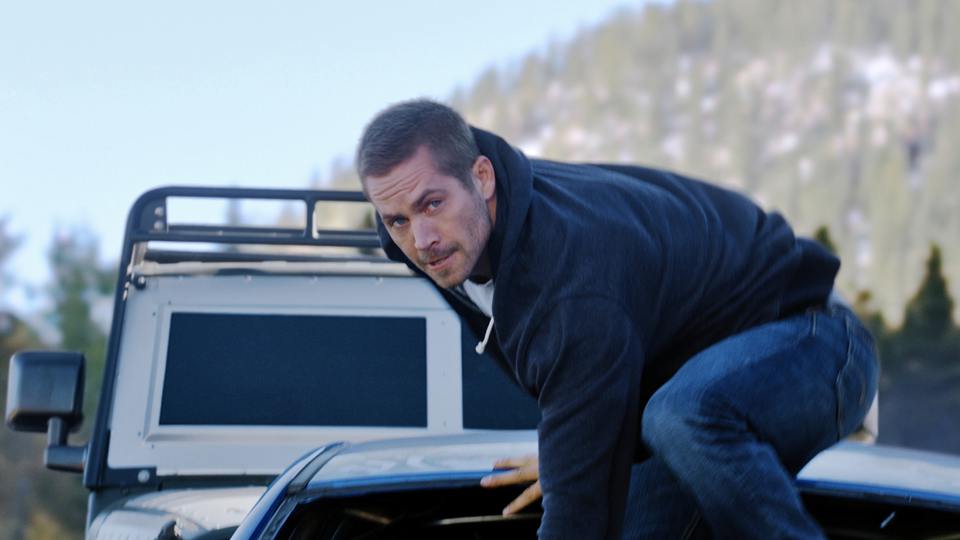
Furious 7 says goodbye to Paul Walker with wall-to-wall action absurdity
The Fast And Furious series may have grown and mutated in directions no one could have anticipated nearly 15 years ago, but give the franchise some credit: It never forgets its roots. Although the globe-trotting three-ring circus of ambitious action climaxes on display in Furious 7 bears little superficial resemblance to the small-scale street-racing thriller The Fast And The Furious, the 2001 original is the subject of multiple callbacks, flashbacks, and, in the end, tearful reflections. The series has long established itself as particularly adept at sly retcons and continuity maintenance—since the fourth film, every entry has featured at least a few dramatic entrances and/or exits. But paying homage seems especially important this time around, because it’s the last film that will star the late Paul Walker as Brian O’Conner, the former cop (and, later, former FBI agent) so transfixed by the street-racing world of Dominic Toretto (Vin Diesel) that he permanently joined his ragtag crew, knocked up Toretto’s sister Mia (Jordana Brewster), and embarked on all manner of dangerous heists, rescues, and revenge missions.
Those adventures continue in Furious 7; despite the nods at series history, this is not a back-to-basics enterprise. The film finds a settled Brian, Mia, Dom, and Letty (Michelle Rodriguez) hunted by Deckard Shaw (Jason Statham), the lethal and unstoppable older brother of the bad guy from Fast & Furious 6. In the end credits of that film, Shaw was retconned into responsibility for the death of Han (Sung Kang), and near the beginning of this one, he mounts an ill-advised but surprisingly effective attack on the towering, sweaty mountain of Agent Hobbs (Dwayne Johnson), with his sights set on the rest of Dom’s makeshift family. As Dom initiates counter-revenge measures, a mysterious government operative called Mr. Nobody (Kurt Russell) steps in with an offer that includes all of the tenets of a latter-day Fast movie rolled into one: rescue a kidnapped hacker and heist the hacker’s all-powerful computer program, and he’ll help the gang (also including, as ever, Tyrese Gibson and Ludacris) get revenge on Shaw.
In other words, Russell provides the means and the excuse for Furious 7 to try topping the fifth and sixth films in nutty commitment to big-scale action and insistent defiance of petty, trifling gravity. To that end, cars chase each other down mountains, Dom drives indoors and then out a window, and Dwayne “The Rock” Johnson fights Jason Statham, among other stunts. To briefly describe these sequences does little to spoil their giddy ingenuity. Though the Fast cycle remains more gimcrack and flashy than the suspense-driven Mission: Impossible series, it shows similar facility with joyfully elaborate set pieces.
Notably, the man in charge of those set pieces this time around has changed for the first time in about a decade: James Wan takes over for Justin Lin, who directed parts three through six. Wan has shown a flair for slow-burn camera work in horror movies like Insidious and The Conjuring, but here he largely adapts to the Fast house style. If anything, some of the filmmaking is slightly less elegant than in Lin’s films: the close-ups are a little tighter, the cuts are a little faster, and a few long pans during exposition scenes look like they’ve been chopped up (maybe by one of the film’s four editors). Amusingly, the director of the original Saw does slip some of his favorite low-rent exploitation imagery into the big-budget proceedings. Several late-movie confrontations take place in and around a parking garage and a dimly lit warehouse, and multiple scenes include large industrial fans spinning slowly in the background, just as one did in the John Goodman scene from Wan’s Death Wish re-do Death Sentence. Wan also adds a signature fight-scene move where the camera locks on a subject as he or she flips, falls, or slams to the floor, tilting along with the body in motion. He pulls this trick at least four times (Furious 7 has a lot of fight scenes, all pretty great) and it never wears out its welcome.
Like all of its predecessors, Furious 7 has peculiarities and problems that aren’t fully absorbed into the intoxicating silliness, like hiring the talented Djimon Hounsou to play a bad guy, only to give him dialogue that consists largely of screaming “What?!” and “Fire!” at his lackeys. Elsewhere in the villain lineup, Statham is well deployed in fights, but doesn’t get much of a chance to chew on gloriously ridiculous dialogue the way Johnson does. As effective as the film is at gathering action icons, it sometimes feels like a fantasy camp for the less physical members of the cast: Ludacris sheds his tech-expert role to dole out an inexplicable beatdown, and due respect to Paul Walker, but he’s no hardcore action fan’s idea of a dream match-up against Tony Jaa, the dexterous star of Ong-Bak.
A little flattery seems in order, though; Walker died before production on Furious 7 was finished. (His work was completed with stand-ins, including two of his brothers, and computer effects, and the seamlessness of these techniques dispels natural fears of uncanny creepiness.) The film’s ensemble sprawls less than previous installments—some supporting players feel more slotted in than usual—which allows the movie to focus on Dom and Brian, whose relationship is more the heart of the series than any conventional romance (though Diesel and Rodriguez also share a substantial romantic subplot). Furious 7 most differentiates itself from its predecessors by unexpected necessity, parlaying the films’ incessant talk of loyalty and family into a touching tribute to Walker, delivered with rumbling sincerity by that old softie Vin Diesel. The series will doubtless continue on with Diesel, Rodriguez, Johnson, and the rest, but in the meantime, Furious 7 comes to the most conclusive and emotionally satisfying ending since, fittingly, the very first film.
